Toebox
The toebox is the section of footwear that surrounds the toes on closed-toe shoes.[1] Toeboxes that do not fit can cause injuries and foot deformities. Toeboxes come in a variety of shapes and styles of construction, some of which are a matter of fashion, and some of which are designed for specialized functions.
.jpg.webp)
Fitting

A simple way to test if a toe box is too tight is to take out the insole and stand on it. If the toes overhang the insole, the toebox is too small.[2]
A toe box also needs enough extra room to accommodate movements of the foot, such as lengthening arches and toe splay.[3] With each step, ankles and feet bend, toes spread and flex,[3] and the arches of the foot flatten and rebound. Because the arches flatten,[4] the foot lengthens[5][3] and widens as it takes weight.[4]:82–83 Weight-bearing causes the foot to widen across the ball by up to 0.5 inches (1.3 cm). A foot with a higher longitudinal arch will lengthen more in use, and more room in front of the toes may be needed.[4]:82–83
When running, weight is shifted onto the ball and toes of the foot; the heel barely touches. A narrow toebox therefore hinders function more.[4]:33 High heels also shift weigh onto the toes.
Problems
Generally, toes should not touch toeboxes. Toeboxes that put pressure on the foot slowly produce permanent deformities; toe boxes that strike the toes cause bruising; and toeboxes that rub hurt the skin.
Joint deformities
Too-tight toeboxes can permanently deform the foot, weakening it enough to significantly impair function.[4]:106,110–113 Tight socks can have similar effects, especially if the foot is already fairly deformed.[4]:105138
Roomy toeboxes which permit free movement help; the improvement depends on the amount and duration of the deformity, and the age of the patient.[4]:107,112 If too-narrow and too-short toeboxes have previously been worn, the muscles of the arches will be weaker; the foot may expand more, and the muscles may feel tired and painful until they strengthen.[4]:83 Foot exercize and broader shoes tend to thicken and widen the foot; a re-fitting after six months may be needed, although after that the shoe size of adults generally stabilizes.[4]:90
Bunions
Shoes which put pressure on the outside edge of the big toe cause bunion (bending of the big toe sideways towards the other toes). Bunion prevention requires a shoe with a sole which does not taper on that side, so that the big toe can point in its natural direction.[4]:103–105 Any material bunion deformity appreciably weakens the foot; the sideways shift in the big toe decreases leverage and shifts weight-bearing. However, this deformity is very common. A bunionette, a similar bending of the little toe, is caused by a too-narrow toebox which puts pressure on the other side of the toes; it is not uncommon, but generally causes less impairment, as the little toe is less mechanically important.[4]:105 Women over 50 who remember wearing narrow toeboxes in their 20s and 30s are more likely to have foot pain and bunions.[1]
Hammertoes
Tight toeboxes are the most common cause of hammertoes, mallet toes and claw toes. A too-small toebox forces the toes to bend; eventually, the ligaments in the top of the foot shorten, and the toes no longer relax to a straight position when taken out of the shoes. If the ligaments continue to tighten, it may become impossible to straighten the toes.[6]
Wearing wide, roomy toeboxes which are longer than the longest toe, and are not tight or painful anywhere, prevents and treats hammertoes. High heels can force the toes forwards against the ends of the toebox, so they should also be avoided.[6] Shoes should fasten such that the toes do not slide into a collision with the end of the toebox, especially when going downhill.[7]
Skin and nail problems
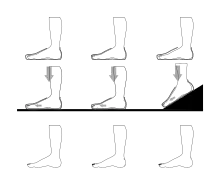
Blisters and calluses
Ill-fitting toeboxes can rub against the foot, causing blisters,[7] and eventually calluses and corns. These often occur on the toes and the balls of the foot.[4]:110–113[7] Foot deformation and dysfunction can encourage calluses to form.[7]
Jogger's toes
If the toebox does not have enough room around the toes, or the foot can slide forwards far enough to jam the toes into the end of the toebox, it can also cause black toenail (jogger's toe).[7] The toes also need vertical space; a toe cap which is low enough to press on the top of the toe may also cause bruising under the nail, especially if the toe cap is stiff. If the toebox is pointed, the toes may be wedged forwards into the area with inadequate height.[4]:52–53,135
Ingrown toenails
Narrow pointed shoes (or tight socks) can be a factor in causing ingrown toenails.[8]
Vertical profile
Toes boxes are either structured (with a three-dimensional shape, often produced with a thermoplastic interlayer) or unstructured. Structuring mostly affects the depth of the toebox.[9] Some moccasins have wide, unstructured toeboxes, somewhat loose on the foot, which allow toe splay.[10] Many toe boxes also include toe spring, where the sole curves up towards the toes. When the shoe is flexible enough to bend with the foot, at the ball of the foot, this is not needed. Most toeboxes, at a point 5 cm from the tip, are ~44 mm deep, regardless of style.[11] Especially wide and deep toeboxes may be used to provide space for foot deformities and foot orthotics.[12]
.jpg.webp) A pair of boots with symmetrically-pointed unstructured square toeboxes.
A pair of boots with symmetrically-pointed unstructured square toeboxes. All-wooden clogs are rigid. While they are fairly foot-shaped inside, they often have bulky, pointed "duck-tail" external toeboxes, with substantial external toe spring
All-wooden clogs are rigid. While they are fairly foot-shaped inside, they often have bulky, pointed "duck-tail" external toeboxes, with substantial external toe spring ...this allows the shoes to rock forwards, so the foot can push off in a fairly normal gait
...this allows the shoes to rock forwards, so the foot can push off in a fairly normal gait
Horizontal profile
Toe boxes also come in various widths and horizontal-plane shapes. Foot-shaped toeboxes are rare.[13] Most toe boxes are widest at the ball of the foot, then taper towards the toes, although the foot widens from the base of the toes forwards.[14] Toe boxes often taper symmetrically, from both sides;[15] feet do not. If toebox taper is wide enough that it is outside the space needed by the foot, a tapered toebox can be comfortable.[13] Many shoes have a toebox which is excessively narrow in relation to heel width; if a sufficiently wide toebox can be picked out, the shoe will often be loose on the heel. Some shoe manufacturers make "split sizes", where the toe and heel size are varied independently, on a combination last.[16]

 A rounded, asymmetical toebox, probably fairly deep. The toebox does not narrow on the inside, allowing the big toe to point straight forward
A rounded, asymmetical toebox, probably fairly deep. The toebox does not narrow on the inside, allowing the big toe to point straight forward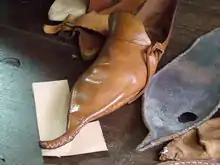
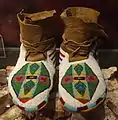
Split toeboxes
Some toeboxes are split. Some are split into two pockets, like those of jika-tabi; others are split into more pockets. Five-pockets toeboxes can be difficult to fit, as each pocket may be too long, too short, too wide, or too narrow. Splitting the toebox helps allow toe splay and gripping.[17][10]
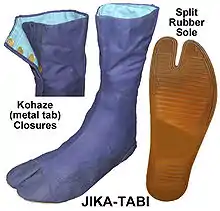 Jika-tabi with a split two-pocket tabi toebox
Jika-tabi with a split two-pocket tabi toebox Five-toed shoes, transparent. It can be seen that the wearer's big toes are a bit too long for their pockets, and the small toes too short.
Five-toed shoes, transparent. It can be seen that the wearer's big toes are a bit too long for their pockets, and the small toes too short. A more conventional shoe with a five-pocket toebox
A more conventional shoe with a five-pocket toebox.jpg.webp) Four-pocket toebox
Four-pocket toebox
Applications
Military
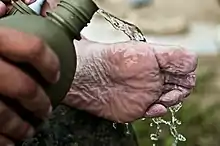
An early-20th-century survey by the United States Army Medical Corps's Army Shoe Board found that less than five percent of the enlisted men had good feet, and attributed most of the problems to poor shoe fit (including civilian shoes).[4]:101–102 The toeboxes of the new military-issue shoes were therefore designed to fit mildly deformed rather than underformed feet.[4]:104–105 The Shoe Board recognized that fit would be imperfect, and recommended breaking in new shoes rapidly by standing in them in three inches of water for ~5 minutes, to soak the leather through, and then walking on a level surface outdoors for ~1 hour, or until the shoes have dried. Failing this, they suggested breaking them in by wearing them for initially short periods, progressively lengthened, to break in the shoe rather than the foot. They also recommended using special shoe stretchers with removable pegs to stretch the toeboxes wider, and stretch bumps over blisters, corns, and bunions.[4]:88–90
Ballet
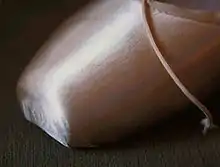
Ballet pointe shoes have highly specialized toeboxes, as the end of the toeboxes, called the platform, must bear a dancer's entire weight when dancing en pointe. This is a pressure of about 220 psi or 1.5 MPa. When a dancer leaps and lands en pointe, the higher transient load, acting on the same area, briefly creates a much higher pressure. The toebox is a rigid socket, built from layers of paper, glue, and fabric (usually burlap), and covered with a satin fabric. They sometimes contain plastic, but this tends to produce a stiff shoe and is not popular. The toe boxes start out too stiff to dance in, and must be broken in; after a certain amount of dancing, depending on technique and conditions, the toeboxes become too soft to support the foot. Reinforcement with fresh glue may postpone the date when the shoes must be replaced.[5]
The toebox must be carefully fitted. The width of the toe box must accord with the dancer's toe shape. When the dancer stand with the feet pointing straight ahead and parallel (sixth position), and bends their knees deeply without raising their heels from the floor (a demi-plié), the feet lengthen; the toes should just touch the platform when in this position. The top of the toebox should be long enough that the throat (edge) falls a bit beyond the far end of the third phalanx, covering it entirely. Dancers often wear specialized padding around and between their toes.[5]
Creasing
A stiff, multipiece shoe with toe caps, which has been left on the last a long time, will crease less across the toebox. Leather quality has little effect. Using a shoe tree and a shoehorn will reduce creasing. Creasing is a cosmetic concern, but generally does not impair function.[18]
References
- Jellema, AH; Huysmans, T; Hartholt, K; van der Cammen, TJM (September 2019). "Shoe design for older adults: Evidence from a systematic review on the elements of optimal footwear". Maturitas. 127: 64–81. doi:10.1016/j.maturitas.2019.06.002. PMID 31351522.
- Allan, Isom (19 April 2016). "Is Your Toe Box Wide Enough? The Simple Test for Running Success". Coury & Buehler Physical Therapy.
- "Our Shoe Fitting Process". Charm City Run.
- Munson, Edward Lyman (1912). The soldier's foot and the military shoe; a handbook for officers and noncommissioned officers of the line. Menasha, Wis.: Press of the George Banta publishing company. (this is the publication of a four-year review into the footwear of the US military by the Army Shoe Board, of which the author, a physician and senior officer of the United States Army Medical Corps, is president. His statements on flat feet are out of date, but on toeboxes, no significant work seems to have been done since)
- Shah, Selina (April 2010). "Pointe shoes complicate biomechanics of ballet". Lower Extremity Review Magazine.
- Publishing, Harvard Health. "Hammertoe". Harvard Health.
- Mailler, EA; Adams, BB (August 2004). "The wear and tear of 26.2: dermatological injuries reported on marathon day". British Journal of Sports Medicine. 38 (4): 498–501. doi:10.1136/bjsm.2004.011874. PMC 1724877. PMID 15273194.
- Haneke, E (2012). "Controversies in the treatment of ingrown nails". Dermatology Research and Practice. 2012: 783924. doi:10.1155/2012/783924. PMC 3362847. PMID 22675345.
- "Structured vs Unstructured Toe Box and Shoe Sizing". Aun Three Photography. 24 January 2018.
- Justin (Mar 21, 2011). "Why Toe Shoes? The Benefits of Toe Separation for Barefoot Feel and Shoe Functionality". Birthday Shoes.
- Kaye, RA (March 1994). "The extra-depth toe box: a rational approach". Foot & Ankle International. 15 (3): 146–50. doi:10.1177/107110079401500310. PMID 7951943.
- Frecklington, M; Dalbeth, N; McNair, P; Gow, P; Williams, A; Carroll, M; Rome, K (June 2018). "Footwear interventions for foot pain, function, impairment and disability for people with foot and ankle arthritis: A literature review". Seminars in Arthritis and Rheumatism. 47 (6): 814–824. doi:10.1016/j.semarthrit.2017.10.017. PMID 29174793.
- Larson, Peter (March 30, 2011). "Altra Instinct Running Shoe Review: Zero Drop, Foot Shaped, and Cushioned". runblogger.com.
- "Wide Shoes vs. Wide Toe Box: What Keeps Feet Comfortable?". SOM Sense Of Motion Footwear.
- Branthwaite, H; Chockalingam, N; Greenhalgh, A (2013). "The effect of shoe toe box shape and volume on forefoot interdigital and plantar pressures in healthy females". Journal of Foot and Ankle Research. 6: 28. doi:10.1186/1757-1146-6-28. PMC 3737013. PMID 23886242.
- Coughlin, MJ; Thompson, FM (1995). "The high price of high-fashion footwear" (PDF). Instructional Course Lectures. 44: 371–7. PMID 7797875.
- "Split Toe (Tabi) Shoes and Why You Want Them". Toe Salad.
- "4 Factors That Lead To Unsightly Leather Dress Shoe Creasing And How to Prevent Them". CustomMade.